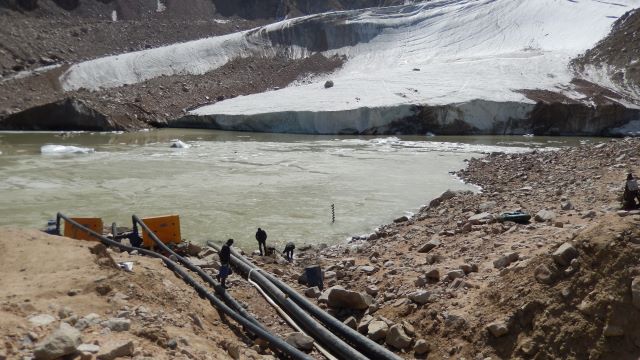By repurposing a technical geo-surveying technique as a practical management tool, a team of Reading researchers are helping to mitigate the potentially catastrophic effects of climate change in Central Asia.
As climate change intensifies, a dangerous type of flood known as a ‘glacial lake outburst flood’ is becoming increasingly common. Caused by the failure of a dam of ice containing a huge pocket of water within a glacier, these floods can cause an enormous amount of damage in a very short time.
In Central Asia, the approach being taken by risk reduction agencies to managing glacial lakes has been transformed in recent years, as a result of research by a team of Reading scientists. Led by Professor Maria Shahgedanova, the team developed a new technique to predict the formation and expansion of glacial lakes using an existing technical model.
Shahgedanova and her colleagues used the Glacier Bed Topography (GlabTop) model – typically used to measure the thickness of glacial ice – to predict the future size and shape of glacial lakes. This enabled agencies in Kazakhstan, Uzbekistan, Kyrgyzstan and Tajikistan to focus their risk-reduction activities on the lakes with the strongest potential for growth.
In 2022, the project was expanded to enable better prediction of ‘debris-flow’ events. The researchers developed an interactive GIS database of the meteorological contexts of past debris-flow events, alongside an app to facilitate real-time risk assessment.
“This is an important step in developing an early-warning system providing a significant improvement in the operational work of the disaster-relief agencies in Central Asia.” Professor T. O. Balykbayev, Director of UNESCO Central Asian Regional Glaciological Centre (CARGC)
Judges’ comment
“A very good strategically targeted engagement approach, including the co-production of knowledge, that clearly demonstrates the benefits to local partners and delivers critical impact in reducing the hazard potential of glacier floods.”
Team: Maria Shahgedanova
In partnership with Central Asian Regional Glaciological Centre, Kazakhstan Institute of Geography, Kazakhstan State Agency for Mudflow Protection, Al-Farabi Kazakh State National University, Uzbekistan Institute of Geology and Geophysics, Uzbekistan Hydrometeorological Institute
Funded by Newton Fund, UKRI, University of Reading
Shortlisted for the University Research Engagement and Impact Awards 2022 (winner)
First published: June 2022

